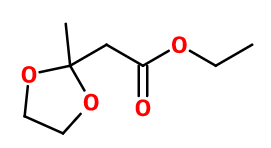Fructone®
Synthétique
Fruity > Green Fruits > Butyric > Tropical Fruits

Crédits photo: ScenTree SAS
Other names :
Jasmaprunate® ; Aplifine® ; Frutimety® ; Methyl Dioxolan ; Applinal® ; Ethyl 2-(2-methyl-1,3-dioxolan-2-yl) acetate ; Apple ketal ; Applinal ; Applitone ; Ethyl aceto acetate EG acetal ; Ethyl acetoacetate ethylene glycol ketal ; Ethyl-2-methyl-1,3-dioxolane-2-acetate ; Fragolan ; Frutinal ; Ketopommal ; Methyldioxolan
Volatility :
Head/Heart
Uses in perfumery :
Fructone® is used in fruity notes for all types of fruit. Useful in rose notes for a fruity nuance, in green, aromatic and marine notes. if overdosed, addition of a fermented facet.
Natural availability :
Fructone® is not available in its natural state.
Year of discovery :
1938
Other comments :
Data not available.
Price Range :
€
Stability :
Stable in perfumes and diverse functional bases

Crédits photo: ScenTree SAS
- Molecular formula :
- C8H14O4
- Molecular Weight :
- 174,2 g/mol
- Density :
- 1,085
- Flash Point :
- 94°C
- Fusion Point :
- Donnée indisponible.
- Appearance :
- Colorless liquid
- Log P :
- 0,98
- Boiling Point :
- 95°C
- Detection Threshold :
- Donnée indisponible.
Synthesis route :
Fructone® and an acetal of Ethyl Acetoacetate (synthesis from formic acid and acetone in its enol form), obtained by reaction between this reagent and ethylene glycol.
Synthesis precursor :
Fructone® is not a precursor to the synthesis of another compound of olfactory interest.
Isomerism :
Fructone® does not have an isomer used in perfumery.
- EINECS number :
- 229-114-0
- FEMA number :
- 4477
- JECFA number :
- 1969
- FLAVIS number :
- Donnée indisponible.
- Allergens :
- This ingredient does not contain any allergen.
- IFRA :
- This ingredient is not restricted
To learn more about IFRA's standards : https://ifrafragrance.org/safe-use/library
ScenTree is solely responsible for the information provided here.

